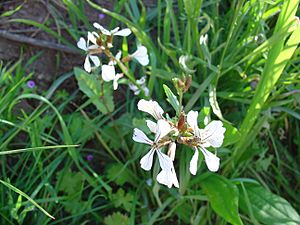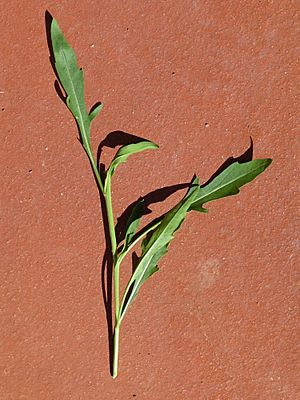Eruca vesicaria facts for kids
Quick facts for kids Eruca vesicaria |
|
|---|---|
 |
|
| Scientific classification | |
| Genus: |
Eruca
|
| Species: |
vesicaria
|
Rocket or arugula is a leafy green plant that people eat. It's known for its fresh, slightly bitter, and peppery taste. You might also hear it called garden rocket or roquette. This plant, scientifically named Eruca vesicaria, is a type of annual plant, meaning it lives for only one growing season. It belongs to the Brassicaceae family, which also includes plants like cabbage and broccoli. Rocket originally comes from the Mediterranean region, covering areas from Morocco to Turkey.
Contents
What Does Rocket Look Like?
Rocket plants can grow quite tall, from about 20 to 100 centimeters (8 to 39 inches) high. Their leaves are deeply cut, almost like feathers, with several small side parts and one larger end part.
The flowers of the rocket plant are usually 2 to 4 centimeters (about 1 inch) wide. They grow in clusters and have the typical four-petal shape of the Brassicaceae family. The petals are creamy white with pretty purple lines, and the center has yellow parts.
After the flowers, the plant produces fruits that look like long, thin pods, about 12 to 25 millimeters (0.5 to 1 inch) long. These pods contain several small, edible seeds.
The Name of Rocket
The scientific name for rocket, Eruca vesicaria, sometimes includes the word sativa. The word sativa comes from a Latin word meaning "to sow." This tells us that people have been planting the seeds of this plant in gardens for a very long time.
The English name rocket comes from the Italian word Ruchetta or rucola. This word itself comes from the Latin word eruca, which was an old name for a type of cabbage-like plant. In the United States and Canada, the name arugula became popular. It also came from an Italian word.
Sometimes, rocket is confused with another plant called "perennial wall rocket." Both are used in similar ways, but they are different plants.
Where Rocket Grows (Ecology)
Rocket usually grows well in dry, disturbed soil. It's a food source for the young forms (larvae) of some moths, like the garden carpet moth. Its roots can sometimes be affected by tiny worms called nematodes.
Growing Rocket and Its History
Rocket is a healthy leafy green vegetable. It's full of important nutrients like vitamin C and potassium. Not only are the leaves eaten, but the flowers, young seed pods, and even the mature seeds are also edible!
People in Italy have been growing and eating rocket since the time of the Roman Empire. Ancient Roman writers even mentioned it. For a long time, rocket was gathered from the wild or grown in home gardens, just like parsley and basil.
Today, rocket is grown on large farms and sold in supermarkets and farmers' markets all over the world. It has also spread and now grows wild in many places outside its original home, including parts of Europe and North America. In India, the mature seeds are called Gargeer.
If the weather gets too cold, the green leaves of the rocket plant can sometimes turn red.
How People Use Rocket
Since Roman times, fresh rocket has been a popular addition to salads, especially in Italy. It's often put on top of pizza right after it comes out of the oven.
In southern Italy, people also cook rocket. They might add large amounts of chopped rocket to pasta dishes with tomato sauce and cheese. It's also used in sauces or cooked dishes, or even fried in olive oil with garlic to go with cold meats and fish. You might find it mixed with boiled potatoes or in soups. In Rome, rocket is used in a dish called straccetti, which has thin slices of beef with raw rocket and Parmesan cheese.
In Turkey, rocket is eaten raw as a side dish or salad with fish. It's often served with a dressing made from olive oil and lemon juice.
In West Asia, Pakistan, and Northern India, the seeds of the rocket plant are pressed to make an oil called taramira oil. This oil is used for pickling and, after it's aged, as a salad or cooking oil. The leftover part of the seeds after the oil is extracted is used to feed animals.
Rocket's Nutrition
| Nutritional value per 100 g (3.5 oz) | |
|---|---|
| Energy | 105 kJ (25 kcal) |
|
3.6 g
|
|
| Sugars | 2.0 g |
| Dietary fiber | 1.6 g |
|
0.6 g
|
|
|
Protein
|
2.6 g
|
| Vitamins | Quantity
%DV†
|
| Vitamin A equiv.
beta-Carotene
lutein zeaxanthin
|
15%
119 μg
13%
1424 μg3555 μg
|
| Vitamin A | 2373 IU |
| Thiamine (B1) |
4%
0.044 mg |
| Riboflavin (B2) |
7%
0.086 mg |
| Niacin (B3) |
2%
0.305 mg |
| Vitamin B6 |
6%
0.073 mg |
| Folate (B9) |
24%
97 μg |
| Vitamin C |
18%
15 mg |
| Vitamin E |
3%
0.43 mg |
| Vitamin K |
103%
108.6 μg |
| Minerals | Quantity
%DV†
|
| Calcium |
16%
160 mg |
| Copper |
4%
0.076 mg |
| Iron |
11%
1.46 mg |
| Magnesium |
13%
47 mg |
| Manganese |
15%
0.321 mg |
| Phosphorus |
7%
52 mg |
| Potassium |
12%
369 mg |
| Sodium |
2%
27 mg |
| Zinc |
5%
0.47 mg |
| Other constituents | Quantity |
| Water | 91.7 g |
|
Full Link to USDA database entry
|
|
| †Percentages estimated using US recommendations for adults. | |
Raw rocket is mostly water (about 92%). It has some carbohydrates (4%) and protein (2.5%), but very little fat. Even though a 100-gram (about 3.5 ounces) serving only gives you about 105 kilojoules (25 calories) of energy, rocket is very nutritious. It's especially good for you when it's fresh, frozen, steamed, or quickly boiled.
Rocket is an excellent source of folate and vitamin K, providing 20% or more of the Daily Value (DV) for these nutrients. It's also a good source (10-19% of DV) of vitamin A, vitamin C, calcium, magnesium, and manganese.
See also
 In Spanish: Arúgula para niños
In Spanish: Arúgula para niños





